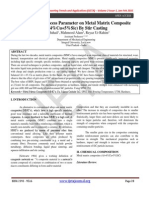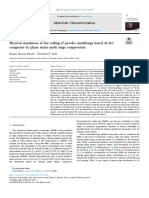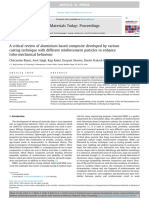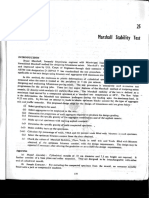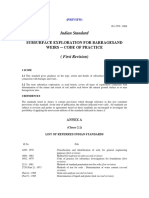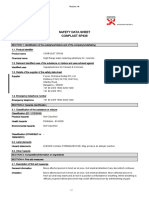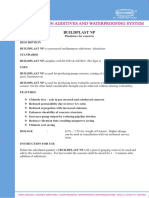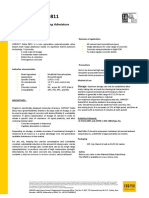24 SAJET NEC-watermark
24 SAJET NEC-watermark
Uploaded by
raviteja036Copyright:
Available Formats
24 SAJET NEC-watermark
24 SAJET NEC-watermark
Uploaded by
raviteja036Original Title
Copyright
Available Formats
Share this document
Did you find this document useful?
Is this content inappropriate?
Copyright:
Available Formats
24 SAJET NEC-watermark
24 SAJET NEC-watermark
Uploaded by
raviteja036Copyright:
Available Formats
Vol.2, No.
1 ISSN Number (online): 2454-9614
Proceedings of International Conference on Recent Trends in Mechanical Engineering-2K15(NECICRTME-2K15), 20th – 21st November,2015
MECHANICAL PROPERTIES OF STIR
CASTED AL6063-SiC METAL MATRIX
COMPOSITE
M.Amrutha Pavani#1,M.Venkaiah#2,
2
Assistant professor,Mechanical Engineering, Narasaraopeta Engineering College,
Affiliated toJNTU Kakinada University, Narasaraopeta, A.P. INDIA
1
pavaniamrutha226@gmail.com
2
venkat.mandula304@gmail.com
Abstract: Several technical challenges exist with is essential for automotive application. These
the casting technology in achieving a uniform properties are not achievable with light weight
distribution of reinforcement within the matrix, monolithic titanium, magnesium, and aluminum
which affects directly on the properties and alloys. Particulate metal matrix composites have
quality of composite material .In the present study nearly isotropic properties when compared to long
a modest attempt would be made to develop fiber reinforced composite. But the mechanical
Aluminum based silicon carbide particulate behavior of the composite depends on the matrix
MMCs with an objective to develop a conventional material composition, size, and weight fraction of the
low cost method of producing MMCs and to reinforcement and method utilized to manufacture the
obtain homogenous dispersion of ceramic composite. The distribution of the reinforcement
material. To achieve these objectives two step- particles in the matrix alloy is influenced by several
mixing method of stir casting technique has been factors such as rheological behavior of the matrix
proposed and subsequent property analysis has melt, the particle incorporation method, interaction of
been made. Aluminum 6063 T6 and SiC particle particles and the matrix before, during, and after
has been chosen as matrix and reinforcement mixing. Non homogeneous particle distribution is one
material respectively. Experiments are planned of the greatest problems in casting of metal matrix
for conducting varying weight fraction of SiC (in composites. Nai and Gupta [1] reported that the
the steps of 5%) while keeping all other average coefficient of thermal expansion of the high
parameters constant. The results would be SiC end was reduced as compared to that of the low
evaluated by Tests-Hardness, Impact (including SiC end. Hashim et al. [2] reported that the
micro-structure) for this ’development method’. distribution of the reinforcement material in the
The trend of hardness and impact strength with matrix must be uniform and the wettability or
increase in weight percentage of SiC would be bonding between these substances should be
observed and recommendation made for the optimized. However, aluminum alloy with
potential applications accordingly. discontinuous ceramic reinforced MMC is rapidly
replacing conventional materials in various
KEYWORDS: MMC (Metal Matrix Composites), SiC automotive, aerospace, and automobile industries.
(Silicon Carbide), Stir Casting Method Amongst various processing routes stir casting is one
of the promising liquid metallurgy technique utilized
I.INTRODUCTION to fabricate the composites. The process is simple,
Metal Matrix Composite (MMC) is engineered flexible, and applicable for large quantity production.
combination of metal (Matrix) and hard particles The liquid metallurgy technique is the most
(Reinforcement) to tailored properties. Metal Matrix economical of all the available technique in
Composites (MMC’s) have very light weight, high producing of MMC.
strength, and stiffness and exhibit greater resistance
to corrosion, oxidation and wear. Fatigue resistance is
an especially important property of Al-MMC, which
128
South Asian Journal of Engineering and Technology (SAJET)
Vol.2, No.1 ISSN Number (online): 2454-9614
Proceedings of International Conference on Recent Trends in Mechanical Engineering-2K15(NECICRTME-2K15), 20th – 21st November,2015
In this study stir casting is accepted as a particularly
promising route, currently can be practiced
commercially. Its advantages lie in its simplicity,
flexibility and applicability to large quantity
production. It is also attractive because, in principle,
it allows a conventional metal processing route to be
used, and hence minimizes the final cost of the
product. This liquid metallurgy technique is the most Fig.2: Silicon carbide (SiC)
economical of all the available routes for metal
matrix composite production, and allows very large Table I
sized components to be fabricated. The cost of Chemical composition of AL-6063 T6
preparing composites material using a casting method
is about one-third to half that of competitive methods, Chemical Element % Present
and for high volume production, it is projected that
Manganese(Mn) 0.0-0.10
the cost will fall to one-tenth.In general, the
solidification synthesis of metal matrix composites Iron(Fe) 0.0-0.35
involves producing a melt of the selected matrix Magnesium(Mg) 0.45-0.90
material followed by the introduction of a
reinforcement material into the melt. To obtain a Silicon(Si) 0.20-0.60
suitable dispersion the stir casting method is used. Zinc(Zn) 0.0-0.10
The solidification of the melt containing suspended
SiC particles is done under selected conditions to Titanium(Ti) 0.0-0.10
obtain the desired distribution. Chromium(Cr) 0.0-0.10
From the past review, it is found that the
number of research work on wear behaviour of Copper(Cu) 0.0-0.10
MMCs have been published, but only few work Other(Each) 0.0-0.05
related to the influence of weight fraction on
Others(Total) 0.0-0.15
mechanical properties like hardness, impact strength,
percentage of elongation etc., have been reported. In Aluminium(Al) Balance
this study, different weight fractions of Silicon
Carbide particulates are added with aluminium 2.2. Method
matrix to fabricate the Al/SiC metal matrix
composites. Different samples have been fabricated 2.2.1. Stir casting
by melt-stirring casting and their microstructure,
hardness and impact strength are studied.
II.MATERIALS AND FABRICATED
METHOD
2.1. Materials
The base material for the investigation is aluminium
alloy (6063), as-received in the form of round bar as
shown in Fig.1 with a chemical composition
(determined by the use of a spectrometric analyzer)
as presented in Table I. Silicon carbide (SiC) is used
as reinforcement. 1% by weight of pure magnesium
powder is used as wetting agent.Fig.2 shows the
Silicon carbide powder.
Fig 3:(a), (b) Induction resistance furnaces with
temperature regulator cum indicator and (c) Melt-
stirring setup utilized for casting of composites
Stir casting process starts with placing empty crucible
in the muffle. At first heater temperature is set to
500°C and then it is gradually increased up to 900°C.
Fig.1: Aluminum 6063-T6 material High temperature of the muffle helps to melt
129
South Asian Journal of Engineering and Technology (SAJET)
Vol.2, No.1 ISSN Number (online): 2454-9614
Proceedings of International Conference on Recent Trends in Mechanical Engineering-2K15(NECICRTME-2K15), 20th – 21st November,2015
aluminium alloy quickly, reduces oxidation level,
enhance the wettability of the reinforcement particles
in the matrix metal. Aluminium alloy Al6063 is used
as Matrix material. Required quantity of aluminium
alloy is cut from the raw material which is in the
form of round bar. Aluminium alloy is cleaned to
remove dust particles, weighed in the crucible for
melting as shown in Fig 3.During melting nitrogen
gas is used as inert gas to create the inert atmosphere
around the molten matrix. Aluminium 6063, silicon
carbide (SiC) and graphite are used as reinforcement. Fig 4: Pattern making for test specimen
1% by weight of pure magnesium powder is used as
wetting agent. At a time total 700 gram of molten
composite was processed in the crucible. Required
quantities of reinforcement powder and magnesium
powder are weighed on the weighing machine. Then
it is thoroughly mixed with each other with the help
of blending machine for 24 hour. This mixture is kept
ready 1 day before the test has to carry out. Prior to
conducting the test this mixture is kept for heating in
another heater.
Reinforcements are heated for half hour and
Fig 5:Pouring of molten metal into mould
at temperature of 500°C. When matrix was in the
fully molten condition, Stirring is started after 2 III.RESULTS AND DISCUSSION
minutes. Stirrer rpm is gradually increased from 0 to
300 RPM with the help of speed controller. 3.1 Microstructure
Temperature of the heater is set to 630°C which is
below the melting temperature of the matrix. A Metallographic samples were sectioned from the
uniform semisolid stage of the molten matrix was cylindrical cast bars. A 0.5 % HF solution was used
achieved by stirring it at 630°C.Pouring of preheated to etch the samples wherever required. To see the
reinforcements at the semisolid stage of the matrix difference in distribution of SiC particles in the
enhance the wetability of the reinforcement, reduces aluminum matrix, microstructure of samples were
the particle settling at the bottom of the crucible. developed on Inverted type Metallurgical Microscope
Reinforcements are poured manually with the help of (Make: Nikon, Range-X50 to X1500). Fig4 show
conical hopper. The flow rate of reinforcements Micrograph of Al/Sic-MMC’s samples for different
measured was 0.5 gram per second. Dispersion time weight fraction (5%, 10%, 15%) of SiC particles.
was taken as 5 minutes. After stirring 5 minutes at Optical micrographs showed reasonably uniform
semisolid stage slurry was reheated and hold at a distribution of SiC particles. In this Al matrix SiC
temperature 900°C to make sure slurry was fully particles are clearly labeled.
liquid. Stirrer RPM was then gradually lowered to the
zero. The stir casting apparatus is manually kept side
and then molten composite slurry is poured in the
metallic mould as shown in Fig 4. Mould is preheated
at temperature 500°C before pouring of the molten
slurry in the mould. This makes sure that slurry is in
molten condition throughout the pouring.
While pouring the slurry in the mould the Fig 6(a): Al6063-SiC 5% Fig 6(b):Al6063-SiC 10%
flow of the slurry is kept uniform to avoid trapping of
gas. Then it is quick quenched with the help of air to
reduce the settling time of the particles in the matrix
as shown in Fig 5.
130
South Asian Journal of Engineering and Technology (SAJET)
Vol.2, No.1 ISSN Number (online): 2454-9614
Proceedings of International Conference on Recent Trends in Mechanical Engineering-2K15(NECICRTME-2K15), 20th – 21st November,2015
Fig 6(c):Al6063-SiC15%
Micrograph of Al/Sic-MMC’s samples for different
Fig 7: Hardness testing machine
weight fraction (5%, 10%, 15%) of SiC particles
3.2 Hardness
Hardness is another measure of the ability of a
material to be deformed. There are many different
tests of hardness measurement.
3.2.1 BHN
The brinell test consists of indenting the surface of
the metal by a hardened steel ball under a load. The
load is applied by lever system and the specimen is Fig 8(a): Al - 5% of SiC hardness test
placed on stage with its ground face upwards. The
height of the specimen can be raised by hand wheel
so that the specimen is brought into contact with the
indenter which is forced into the specimen by the
specified load.
Formula for Brinell hardness
B.H.N = --(1) where
√
Fig8(b): Al - 10% of SiChardness test specimen
P= load applied (kgf)
D= diameter of indenter (mm)
d = diameter of indentation (mm)
3.2.2 Rockwell
In the Rockwell hardness test, the hardness is
determined by the depth of penetration of a indenter,
Fig 8(c): Al - 15% of SiChardness test specimen
rather than by surface area of the indentation. The
specimen placed on stage is brought into contact with TableII
the penetrator , the penetrator is then slowly forced
into the specimens surface by weights acting through Brinell& Rockwell hardness results in BHN & RCN
a system of levers.
% of sicp 5% 10% 15%
Model RAB from SEU Pvt. Ltd type BRINELL 86 96 97.5
equipment was used tomeasure the two types of ROCKWELL 16 26 27.5
hardness at load=150kgf, ball=2.5mm. Yield &
ultimate strength values were shown in tabular form
in TableIIand test specimens of different Sic
compositions are also shown in Fig8 (a,b,c) and
graphically in Fig 9.
131
South Asian Journal of Engineering and Technology (SAJET)
Vol.2, No.1 ISSN Number (online): 2454-9614
Proceedings of International Conference on Recent Trends in Mechanical Engineering-2K15(NECICRTME-2K15), 20th – 21st November,2015
150
100
Rockwell
50 Brinell
0
5% 10% 15%
Fig 9: Brinell& Rockwell Vs Wt % OfSiC
Fig 11:Impact test specimens
From the above results, we can observe that the
hardness of composite material increasing by varying Impactis a high force or shock applied over a short
the amount % of sic. time period when two or more bodies collide. Such a
force or acceleration usually has a greater effect than
3.3 Impact strength a lower force applied over a proportionally longer
time period of time. The effect depends critically on
This is also known as the Charpy V-notch test is a the relative velocity of the bodies to one another. The
standardized high strain-rate test which determines test results are shown in tabular form in TableIII and
the amount of energy absorbed by a material during graphically inFig 12.
fracture. The Charpy testing machine is available in
variety of sizes. A usual size is one having a capacity Table III
of about 30 KJ for testing metals. A notched
specimen is mounted as simple supported beam and Impact test results in J
heavy pendulum is allowed to strike the specimen
from a fixed height % of SiC 5% 10% 15%
Charpy 7.4 11 18
wt % of sicp
Impact strength N-m
20
15
10 wt % of
sic
5
0
5% 10% 15%
Fig 10: Impact testing machine
Fig 12: Impact strength Vs Wt % of SiC
The charpy testing machine with following
specifications Maximum capacity: 30J,Minimum From the above results, we can observe that the
capacity: 2J,Distance between supports: composition of 15% sichas the highimpact strength
40mm±0.2mm is used for impact test. Impact test comparing to the compositions of about 5%SiC,
specimens at different Sic compositions are as shown 10%SiC
in Fig11.
IV.CONCLUSION
The composition of aluminum with the
increased weight fraction of silicon carbide increases
the mechanical properties. The mechanical properties
like impact and hardness attained maximum at 15%
of SiC. At the composition of Al 6063-SiC from 5%
132
South Asian Journal of Engineering and Technology (SAJET)
Vol.2, No.1 ISSN Number (online): 2454-9614
Proceedings of International Conference on Recent Trends in Mechanical Engineering-2K15(NECICRTME-2K15), 20th – 21st November,2015
to 10% there is a drastic change in mechanical
properties and at 10% to 15% there is small vary in
mechanical properties. Homogenous dispersion of
SiC particles in the Al 6063-SiC particle Composite
shows an increasing trend in the samples prepared by
applying stirring process, with manual stirring and
with 2-Step method of stir casting technique
respectively.Due to the extensive applications of
aluminum 6063/SiC metal matrix composites it is
used in manufacturing industries, structural designs,
automotive parts (hydro dynamic tube chassis)
REFERENCES
[1] Nai, S.M.L. and Gupta, M. ,”Synthesis and
Characterization of Free Standing, Bulk Al/Sicp
Functionally Gradient Materials: Effects of Different
Stirrer Geometries,” Material Research Bulletin, 38:
1573-1589. 2003.
[2] Hashim, J., Looney, L. and Hashmi, M.S.J.,
“Particle Distribution in Metal Matrix Composites,”
Part-I, Journal of Materials Processing Technology,
123: 251-257. 2002.
133
South Asian Journal of Engineering and Technology (SAJET)
You might also like
- (IJCST-V2I1P5) : Mohd Suhail, Mahmood Alam, Mohd - Reyaz-Ur-RahimNo ratings yet(IJCST-V2I1P5) : Mohd Suhail, Mahmood Alam, Mohd - Reyaz-Ur-Rahim6 pages
- A Synonymous Description of Al-Zn Alloy in Different Casting ProcessNo ratings yetA Synonymous Description of Al-Zn Alloy in Different Casting Process9 pages
- The Production of Cast Metal Matrix Composite by A Modified Stir Casting MethodNo ratings yetThe Production of Cast Metal Matrix Composite by A Modified Stir Casting Method12 pages
- Aluminium Metal Matrix Composites - Manufacturing and ApplicationsNo ratings yetAluminium Metal Matrix Composites - Manufacturing and Applications9 pages
- Venkitachalapathy Et Al 2025 Influence of Boron Carbide and Graphite Particulates on the Microstructural and MechanicalNo ratings yetVenkitachalapathy Et Al 2025 Influence of Boron Carbide and Graphite Particulates on the Microstructural and Mechanical14 pages
- A Review On The Intensification of Metal Matrix Composites and Its Nonconventional MachiningNo ratings yetA Review On The Intensification of Metal Matrix Composites and Its Nonconventional Machining16 pages
- Manufacturing processes & recent applications of aluminium metal matrix composite materials_ A reviewNo ratings yetManufacturing processes & recent applications of aluminium metal matrix composite materials_ A review5 pages
- A Review On Properties of Al B4C ComposiNo ratings yetA Review On Properties of Al B4C Composi6 pages
- Materials Characterization: Kanhu Charan Nayak, Prashant P. DateNo ratings yetMaterials Characterization: Kanhu Charan Nayak, Prashant P. Date24 pages
- Comparative Analysis With Micro and Nano Reinforcement MaterialNo ratings yetComparative Analysis With Micro and Nano Reinforcement Material6 pages
- Microstructure, Wear and Corrosion Characteristics of Cu Matrix Reinforced Sic-Graphite Hybrid CompositesNo ratings yetMicrostructure, Wear and Corrosion Characteristics of Cu Matrix Reinforced Sic-Graphite Hybrid Composites9 pages
- Analysis of Stir Die Cast Al-SiC Composite Brake Drums Based On Coefficient of FrictionNo ratings yetAnalysis of Stir Die Cast Al-SiC Composite Brake Drums Based On Coefficient of Friction6 pages
- Processing and Characterisation of Particulate Reinforced Aluminium Silicon Matrix CompositeNo ratings yetProcessing and Characterisation of Particulate Reinforced Aluminium Silicon Matrix Composite6 pages
- Effect of Particulate Reinforced AluminiNo ratings yetEffect of Particulate Reinforced Alumini8 pages
- Synthesis, Characterization and Mechanical Properties of A356.1 Aluminium Alloy Matrix Composite Reinforced With Mgo Nano ParticlesNo ratings yetSynthesis, Characterization and Mechanical Properties of A356.1 Aluminium Alloy Matrix Composite Reinforced With Mgo Nano Particles7 pages
- Anitha 2022 IOP Conf. Ser. Mater. Sci. Eng. 1248 012093No ratings yetAnitha 2022 IOP Conf. Ser. Mater. Sci. Eng. 1248 01209314 pages
- Nano and Hybrid Aluminum Based Metal Matrix Composites: An OverviewNo ratings yetNano and Hybrid Aluminum Based Metal Matrix Composites: An Overview13 pages
- Materials Today: Proceedings: Chitranshu Bharti, Amit Singh, Raja Rahul, Dusyant Sharma, Shashi Prakash DwivediNo ratings yetMaterials Today: Proceedings: Chitranshu Bharti, Amit Singh, Raja Rahul, Dusyant Sharma, Shashi Prakash Dwivedi6 pages
- Improvement of Wear Property of Metal Matrix Composite of Al Alloy-B C by Using Taguchi MethodNo ratings yetImprovement of Wear Property of Metal Matrix Composite of Al Alloy-B C by Using Taguchi Method5 pages
- Investigation On Mechanical Properties and Creep Behavior of Stir Cast Az91-Sic CompositesNo ratings yetInvestigation On Mechanical Properties and Creep Behavior of Stir Cast Az91-Sic Composites7 pages
- Effect of Particulate Reinforced Aluminium Metal Matrix Composite - A ReviewNo ratings yetEffect of Particulate Reinforced Aluminium Metal Matrix Composite - A Review14 pages
- Design and Development of Hybrid Stir Casting ProcessNo ratings yetDesign and Development of Hybrid Stir Casting Process5 pages
- Mechanical Properties and Microstructure of A356 Alloy Reinforced Aln/Mwcnt/Graphite/Al Composites Fabricated by Stir CastingNo ratings yetMechanical Properties and Microstructure of A356 Alloy Reinforced Aln/Mwcnt/Graphite/Al Composites Fabricated by Stir Casting15 pages
- 4578-Article Text-23217-1-10-20221125 (1)No ratings yet4578-Article Text-23217-1-10-20221125 (1)13 pages
- Experimental Characterization of Mechanical Properties of SicCoHybrid Reinforced 6061 Aluminum Metal Matrix CompositesNo ratings yetExperimental Characterization of Mechanical Properties of SicCoHybrid Reinforced 6061 Aluminum Metal Matrix Composites4 pages
- Analysis of Stir Cast Aluminium Silicon Carbide Metal Matrix Composite: A Comprehensive ReviewNo ratings yetAnalysis of Stir Cast Aluminium Silicon Carbide Metal Matrix Composite: A Comprehensive Review7 pages
- Study of Mechanical Properties µstructure of B C Reinforced Aluminum Metal Matrix CompositeNo ratings yetStudy of Mechanical Properties µstructure of B C Reinforced Aluminum Metal Matrix Composite9 pages
- Materials Today: Proceedings: V. Preethi, A. Daniel Das, C. NithyapathiNo ratings yetMaterials Today: Proceedings: V. Preethi, A. Daniel Das, C. Nithyapathi5 pages
- 7th Sem - MCM NOTES-UNIT I-Chapter 3 - MMCs and CMCsNo ratings yet7th Sem - MCM NOTES-UNIT I-Chapter 3 - MMCs and CMCs20 pages
- Role of Stir Casting in Development of Aluminium MNo ratings yetRole of Stir Casting in Development of Aluminium M24 pages
- Effect of Trace Addition of Ceramic On Microstructure Development and Mechanical Properties of Selective Laser Melted Alsi10Mg AlloyNo ratings yetEffect of Trace Addition of Ceramic On Microstructure Development and Mechanical Properties of Selective Laser Melted Alsi10Mg Alloy13 pages
- Investigations On Microstructure, Mechanical, and Tribological Behaviour of Aa 7075 - X WT.% Tic Composites For Aerospace ApplicationsNo ratings yetInvestigations On Microstructure, Mechanical, and Tribological Behaviour of Aa 7075 - X WT.% Tic Composites For Aerospace Applications11 pages
- A Review of Reinforcements and Process Parameters For Powder Metallurgy-Processed Metal Matrix CompositesNo ratings yetA Review of Reinforcements and Process Parameters For Powder Metallurgy-Processed Metal Matrix Composites10 pages
- Tex-601-J, Sampling and Testing Elastomeric Materials: ContentsNo ratings yetTex-601-J, Sampling and Testing Elastomeric Materials: Contents7 pages
- Bostik Screed WP: Prepacked Drymix Waterproof Floor ScreedNo ratings yetBostik Screed WP: Prepacked Drymix Waterproof Floor Screed2 pages
- Buildplast Super-Hr: (ISO 9001: 2015 CERTIFIED)No ratings yetBuildplast Super-Hr: (ISO 9001: 2015 CERTIFIED)2 pages
- Subsurface Exploration For Barragesand Weirs Code of PracticeNo ratings yetSubsurface Exploration For Barragesand Weirs Code of Practice3 pages
- A Review On Use of Metakaolin in Cement Mortar and Concrete: July 2014No ratings yetA Review On Use of Metakaolin in Cement Mortar and Concrete: July 20146 pages
- Ecmas Exf 54: Hybrid Synthetic Structural FiberNo ratings yetEcmas Exf 54: Hybrid Synthetic Structural Fiber3 pages
- Chryso Delta D811: New Generation Plasticizing AdmixtureNo ratings yetChryso Delta D811: New Generation Plasticizing Admixture1 page
- VSP Proportional Directional Control ValvesNo ratings yetVSP Proportional Directional Control Valves8 pages
- The Laws of Exponents and Multiplication and Division of PolynomialsNo ratings yetThe Laws of Exponents and Multiplication and Division of Polynomials37 pages
- Physics Exclusive Sample Paper With SolutionNo ratings yetPhysics Exclusive Sample Paper With Solution25 pages
- B.Tech - Electrical and Electronics Engineering Curriculum and SyllabusNo ratings yetB.Tech - Electrical and Electronics Engineering Curriculum and Syllabus9 pages
- Teaching Oop: A Practical Approach Using BluejNo ratings yetTeaching Oop: A Practical Approach Using Bluej39 pages
- Chalmers University of Technology Master S Thesis (After Correction)No ratings yetChalmers University of Technology Master S Thesis (After Correction)70 pages
- Minimum L - Distance Estimators For Non-Normalized Parametric ModelsNo ratings yetMinimum L - Distance Estimators For Non-Normalized Parametric Models32 pages
- Midterm Examination in General Chemistry 1, 11 Grade - Stem "On All My Work, My Name Affirms My Honor"No ratings yetMidterm Examination in General Chemistry 1, 11 Grade - Stem "On All My Work, My Name Affirms My Honor"3 pages
- Astrological Prediction For Profession Doctor UsinNo ratings yetAstrological Prediction For Profession Doctor Usin5 pages
- 23GE102 - Problem Solving and Python Programming Internal 1 Question PaperNo ratings yet23GE102 - Problem Solving and Python Programming Internal 1 Question Paper3 pages
- Isaacv1.7.8a.0000 20220620 164530 25952 33760No ratings yetIsaacv1.7.8a.0000 20220620 164530 25952 33760174 pages
- Sa-Csir, Sa-Cscr: Installation and Operating InstructionsNo ratings yetSa-Csir, Sa-Cscr: Installation and Operating Instructions16 pages
- (IJCST-V2I1P5) : Mohd Suhail, Mahmood Alam, Mohd - Reyaz-Ur-Rahim(IJCST-V2I1P5) : Mohd Suhail, Mahmood Alam, Mohd - Reyaz-Ur-Rahim
- A Synonymous Description of Al-Zn Alloy in Different Casting ProcessA Synonymous Description of Al-Zn Alloy in Different Casting Process
- The Production of Cast Metal Matrix Composite by A Modified Stir Casting MethodThe Production of Cast Metal Matrix Composite by A Modified Stir Casting Method
- Aluminium Metal Matrix Composites - Manufacturing and ApplicationsAluminium Metal Matrix Composites - Manufacturing and Applications
- Venkitachalapathy Et Al 2025 Influence of Boron Carbide and Graphite Particulates on the Microstructural and MechanicalVenkitachalapathy Et Al 2025 Influence of Boron Carbide and Graphite Particulates on the Microstructural and Mechanical
- A Review On The Intensification of Metal Matrix Composites and Its Nonconventional MachiningA Review On The Intensification of Metal Matrix Composites and Its Nonconventional Machining
- Manufacturing processes & recent applications of aluminium metal matrix composite materials_ A reviewManufacturing processes & recent applications of aluminium metal matrix composite materials_ A review
- Materials Characterization: Kanhu Charan Nayak, Prashant P. DateMaterials Characterization: Kanhu Charan Nayak, Prashant P. Date
- Comparative Analysis With Micro and Nano Reinforcement MaterialComparative Analysis With Micro and Nano Reinforcement Material
- Microstructure, Wear and Corrosion Characteristics of Cu Matrix Reinforced Sic-Graphite Hybrid CompositesMicrostructure, Wear and Corrosion Characteristics of Cu Matrix Reinforced Sic-Graphite Hybrid Composites
- Analysis of Stir Die Cast Al-SiC Composite Brake Drums Based On Coefficient of FrictionAnalysis of Stir Die Cast Al-SiC Composite Brake Drums Based On Coefficient of Friction
- Processing and Characterisation of Particulate Reinforced Aluminium Silicon Matrix CompositeProcessing and Characterisation of Particulate Reinforced Aluminium Silicon Matrix Composite
- Synthesis, Characterization and Mechanical Properties of A356.1 Aluminium Alloy Matrix Composite Reinforced With Mgo Nano ParticlesSynthesis, Characterization and Mechanical Properties of A356.1 Aluminium Alloy Matrix Composite Reinforced With Mgo Nano Particles
- Anitha 2022 IOP Conf. Ser. Mater. Sci. Eng. 1248 012093Anitha 2022 IOP Conf. Ser. Mater. Sci. Eng. 1248 012093
- Nano and Hybrid Aluminum Based Metal Matrix Composites: An OverviewNano and Hybrid Aluminum Based Metal Matrix Composites: An Overview
- Materials Today: Proceedings: Chitranshu Bharti, Amit Singh, Raja Rahul, Dusyant Sharma, Shashi Prakash DwivediMaterials Today: Proceedings: Chitranshu Bharti, Amit Singh, Raja Rahul, Dusyant Sharma, Shashi Prakash Dwivedi
- Improvement of Wear Property of Metal Matrix Composite of Al Alloy-B C by Using Taguchi MethodImprovement of Wear Property of Metal Matrix Composite of Al Alloy-B C by Using Taguchi Method
- Investigation On Mechanical Properties and Creep Behavior of Stir Cast Az91-Sic CompositesInvestigation On Mechanical Properties and Creep Behavior of Stir Cast Az91-Sic Composites
- Effect of Particulate Reinforced Aluminium Metal Matrix Composite - A ReviewEffect of Particulate Reinforced Aluminium Metal Matrix Composite - A Review
- Design and Development of Hybrid Stir Casting ProcessDesign and Development of Hybrid Stir Casting Process
- Mechanical Properties and Microstructure of A356 Alloy Reinforced Aln/Mwcnt/Graphite/Al Composites Fabricated by Stir CastingMechanical Properties and Microstructure of A356 Alloy Reinforced Aln/Mwcnt/Graphite/Al Composites Fabricated by Stir Casting
- Experimental Characterization of Mechanical Properties of SicCoHybrid Reinforced 6061 Aluminum Metal Matrix CompositesExperimental Characterization of Mechanical Properties of SicCoHybrid Reinforced 6061 Aluminum Metal Matrix Composites
- Analysis of Stir Cast Aluminium Silicon Carbide Metal Matrix Composite: A Comprehensive ReviewAnalysis of Stir Cast Aluminium Silicon Carbide Metal Matrix Composite: A Comprehensive Review
- Study of Mechanical Properties µstructure of B C Reinforced Aluminum Metal Matrix CompositeStudy of Mechanical Properties µstructure of B C Reinforced Aluminum Metal Matrix Composite
- Materials Today: Proceedings: V. Preethi, A. Daniel Das, C. NithyapathiMaterials Today: Proceedings: V. Preethi, A. Daniel Das, C. Nithyapathi
- 7th Sem - MCM NOTES-UNIT I-Chapter 3 - MMCs and CMCs7th Sem - MCM NOTES-UNIT I-Chapter 3 - MMCs and CMCs
- Role of Stir Casting in Development of Aluminium MRole of Stir Casting in Development of Aluminium M
- Effect of Trace Addition of Ceramic On Microstructure Development and Mechanical Properties of Selective Laser Melted Alsi10Mg AlloyEffect of Trace Addition of Ceramic On Microstructure Development and Mechanical Properties of Selective Laser Melted Alsi10Mg Alloy
- Investigations On Microstructure, Mechanical, and Tribological Behaviour of Aa 7075 - X WT.% Tic Composites For Aerospace ApplicationsInvestigations On Microstructure, Mechanical, and Tribological Behaviour of Aa 7075 - X WT.% Tic Composites For Aerospace Applications
- A Review of Reinforcements and Process Parameters For Powder Metallurgy-Processed Metal Matrix CompositesA Review of Reinforcements and Process Parameters For Powder Metallurgy-Processed Metal Matrix Composites
- Metal Matrix Composites: A Modern Approach to ManufacturingFrom EverandMetal Matrix Composites: A Modern Approach to Manufacturing
- Tex-601-J, Sampling and Testing Elastomeric Materials: ContentsTex-601-J, Sampling and Testing Elastomeric Materials: Contents
- Bostik Screed WP: Prepacked Drymix Waterproof Floor ScreedBostik Screed WP: Prepacked Drymix Waterproof Floor Screed
- Subsurface Exploration For Barragesand Weirs Code of PracticeSubsurface Exploration For Barragesand Weirs Code of Practice
- A Review On Use of Metakaolin in Cement Mortar and Concrete: July 2014A Review On Use of Metakaolin in Cement Mortar and Concrete: July 2014
- Chryso Delta D811: New Generation Plasticizing AdmixtureChryso Delta D811: New Generation Plasticizing Admixture
- The Laws of Exponents and Multiplication and Division of PolynomialsThe Laws of Exponents and Multiplication and Division of Polynomials
- B.Tech - Electrical and Electronics Engineering Curriculum and SyllabusB.Tech - Electrical and Electronics Engineering Curriculum and Syllabus
- Chalmers University of Technology Master S Thesis (After Correction)Chalmers University of Technology Master S Thesis (After Correction)
- Minimum L - Distance Estimators For Non-Normalized Parametric ModelsMinimum L - Distance Estimators For Non-Normalized Parametric Models
- Midterm Examination in General Chemistry 1, 11 Grade - Stem "On All My Work, My Name Affirms My Honor"Midterm Examination in General Chemistry 1, 11 Grade - Stem "On All My Work, My Name Affirms My Honor"
- Astrological Prediction For Profession Doctor UsinAstrological Prediction For Profession Doctor Usin
- 23GE102 - Problem Solving and Python Programming Internal 1 Question Paper23GE102 - Problem Solving and Python Programming Internal 1 Question Paper
- Sa-Csir, Sa-Cscr: Installation and Operating InstructionsSa-Csir, Sa-Cscr: Installation and Operating Instructions



